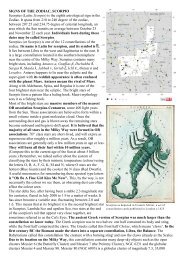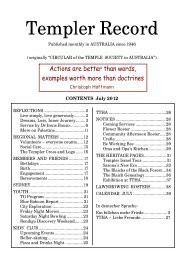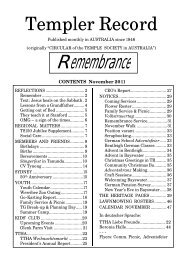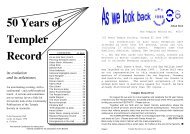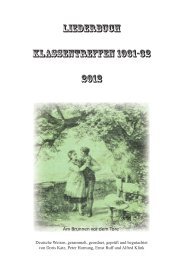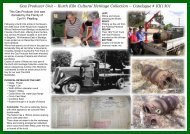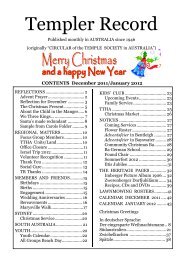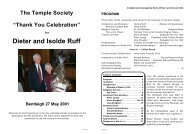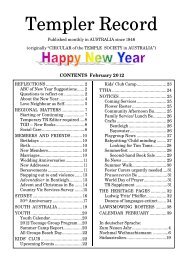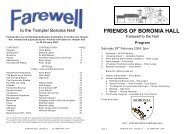Little Green Men, the story of Jocelyn Bell - temple society australia
Little Green Men, the story of Jocelyn Bell - temple society australia
Little Green Men, the story of Jocelyn Bell - temple society australia
Create successful ePaper yourself
Turn your PDF publications into a flip-book with our unique Google optimized e-Paper software.
<strong>Little</strong> <strong>Green</strong> <strong>Men</strong>, <strong>the</strong> <strong>story</strong> <strong>of</strong> <strong>Jocelyn</strong> <strong>Bell</strong><br />
In 1967, <strong>Jocelyn</strong> <strong>Bell</strong> Burnell and Antony Hewish <strong>of</strong> <strong>the</strong> University<br />
<strong>of</strong> Cambridge, UK dubbed <strong>the</strong> first discovered pulsar LGM-1 for<br />
"little green men" because <strong>the</strong> regular oscillations <strong>of</strong> its signal<br />
suggested a possible intelligent origin. Its designation was later<br />
changed to CP 1919, and is now known as PSR B1919+21.<br />
The radio signal was detected in a UK observatory by <strong>Jocelyn</strong> <strong>Bell</strong>.<br />
The signal had a 1.3373 second period and 0.04 second pulsewidth. It<br />
originated at celestial coordinates 19:19 right ascension, 21 degrees<br />
declination. It was detected by individual observation <strong>of</strong> miles <strong>of</strong><br />
graphical data traces. Due to its almost perfect regularity, it was at<br />
first assumed to be spurious noise. A nearby electric fence was even suspected to generate <strong>the</strong> regular pulses;<br />
but this hypo<strong>the</strong>sis was eliminated. After that, <strong>the</strong> discoverers proposed <strong>the</strong> alternative explanation that <strong>the</strong><br />
signal might be a beacon or a communication from an intelligent extraterrestrial civilization and named it<br />
LGM-1, <strong>the</strong> first signal received from <strong>the</strong> ?<strong>Little</strong> <strong>Green</strong> <strong>Men</strong>”.<br />
<strong>Little</strong> green men’ is <strong>the</strong> stereotypical portrayal <strong>of</strong> extraterrestrials as little<br />
humanoid-like creatures with green skin and/or antennae on <strong>the</strong>ir heads. The term is also<br />
sometimes used to describe gremlins, mythical creatures known for causing problems in<br />
airplanes and mechanical devices. During <strong>the</strong> flying saucer "sightings" in <strong>the</strong> 1950s, <strong>the</strong><br />
term little green men came into popular usage in reference to aliens. In one classic case,<br />
<strong>the</strong> Kelly-Hopkinsville sighting on August 21, 1955, two rural Kentucky men described<br />
a supposed encounter with 3–4 foot (1 m) tall metallic-silver, somewhat<br />
humanoid-looking aliens. Employing journalistic licence and deviating from <strong>the</strong><br />
witnesses' accounts, many newspaper articles used <strong>the</strong> term little green men in writing<br />
up <strong>the</strong> <strong>story</strong>. However <strong>the</strong> first use <strong>of</strong> <strong>the</strong> specific phrase "little green man" in reference<br />
to extraterrestrials dates to 1908 in <strong>the</strong> Daily Kennebec Journal,<br />
<strong>the</strong> aliens being Martians. <strong>Green</strong> aliens soon came to commonly<br />
portray extraterrestrials and adorned <strong>the</strong> covers <strong>of</strong> many <strong>of</strong> <strong>the</strong><br />
1920s to 1950s science fiction pulp magazines with pictures <strong>of</strong><br />
Buck Rogers and Flash Gordon battling green alien monsters. The<br />
first documented print example specifically linking "little green<br />
men" to extraterrestrial spaceships is in a newspaper column<br />
satirizing <strong>the</strong> public panic following Orson Welles' famous War<br />
<strong>of</strong> <strong>the</strong> Worlds Halloween broadcast <strong>of</strong> October 31, 1938. The<br />
column by reporter Bill Barnard in <strong>the</strong> Corpus Christi Times <strong>the</strong><br />
next day begins, "Thirteen little green men from Mercury stepped<br />
out <strong>of</strong> <strong>the</strong>ir space ship at Cliff Maus Field [<strong>the</strong> local airport] late<br />
yesterday afternoon for a good-will visit to Corpus Christi" and<br />
ends with, "Then <strong>the</strong> 13 little green men got in <strong>the</strong>ir space ship<br />
and flew away." The familiarity with which <strong>the</strong> term was used suggests that this probably wasn't <strong>the</strong> first<br />
instance where it was applied to extraterrestrials in spaceships. By 1965, a little green man had even appeared in<br />
The Flintstones as a recurring character. The Great Gazoo (introduced in Episode 145) typified <strong>the</strong><br />
representation <strong>of</strong> a little green man with his short, green stature and helmet with antennae.<br />
In <strong>the</strong> end <strong>the</strong> signal turned out to be radio emissions from <strong>the</strong> pulsar CP1919 (<strong>the</strong> first one recognized as<br />
such). <strong>Bell</strong> noted that o<strong>the</strong>r scientists could have discovered pulsars before her, but <strong>the</strong>ir observations were<br />
ei<strong>the</strong>r ignored or disregarded. She noted that Sir Fred Hoyle identified this astronomical object as a neutron<br />
star immediately upon <strong>the</strong>ir announcement.<br />
The road to becoming one <strong>of</strong> <strong>the</strong> most renowned women in science has been a rocky one for <strong>Jocelyn</strong>. Susan<br />
<strong>Jocelyn</strong> <strong>Bell</strong> was born in Belfast, Nor<strong>the</strong>rn Ireland on July 15, 1943. Her fa<strong>the</strong>r was an architect and an avid<br />
reader. Through his books, <strong>Jocelyn</strong> was introduced to <strong>the</strong> world <strong>of</strong> astronomy. Her family and <strong>the</strong> staff <strong>of</strong> <strong>the</strong><br />
Armagh Observatory, which was near her home in Belfast, encouraged her interest in astronomy. <strong>Jocelyn</strong><br />
<strong>Bell</strong>'s parents very strongly believed in educating women. In 1965, <strong>Jocelyn</strong> <strong>Bell</strong> earned a B.S. degree in physics<br />
from <strong>the</strong> University <strong>of</strong> Glasgow. Later that same year she began work on her Ph.D. at Cambridge University. It<br />
was while she was a graduate student at Cambridge, working under <strong>the</strong> direction <strong>of</strong> Antony Hewish, that<br />
<strong>Jocelyn</strong> <strong>Bell</strong> discovered pulsars. <strong>Bell</strong>'s first two years at Cambridge were spent assisting in <strong>the</strong> construction
<strong>of</strong> an 81.5-megahertz radio telescope that was to be used to track quasars. The telescope went into operation<br />
in 1967. It was <strong>Jocelyn</strong> <strong>Bell</strong>'s job to operate <strong>the</strong> telescope and to analyse over 120 metres <strong>of</strong> chart paper<br />
produced by <strong>the</strong> telescope every four days. After several weeks <strong>of</strong> analysis, <strong>Bell</strong> noticed some unusual<br />
markings on <strong>the</strong> chart paper. These markings were made by a radio source too fast and regular to be a quasar.<br />
Although <strong>the</strong> source's signal took up only about 2.5 centimetres <strong>of</strong> <strong>the</strong> 121.8 metres <strong>of</strong> chart paper, <strong>Jocelyn</strong><br />
<strong>Bell</strong> recognized it as unusual and considered it important. She had detected <strong>the</strong> first evidence <strong>of</strong> a pulsar. In<br />
February <strong>of</strong> 1968, news <strong>of</strong> <strong>the</strong> discovery made by <strong>Jocelyn</strong> <strong>Bell</strong> was published in <strong>the</strong> journal Nature. Fur<strong>the</strong>r<br />
studies by groups <strong>of</strong> astronomers around <strong>the</strong> world identified <strong>the</strong> signals as coming from rapidly rotating<br />
neutron stars. These objects, first noticed by <strong>Jocelyn</strong> <strong>Bell</strong>, became known as pulsars. The term pulsar is an<br />
abbreviation for pulsating radio star or rapidly pulsating radio sources. <strong>Jocelyn</strong> <strong>Bell</strong> received her Ph.D. in radio<br />
astronomy from Cambridge University in 1968. She married during that same year and changed her name to<br />
Burnell. Since leaving Cambridge in 1968, Dr. <strong>Bell</strong> Burnell has studied <strong>the</strong> sky in almost every region <strong>of</strong> <strong>the</strong><br />
electromagnetic spectrum. She has received many honours and awards for her contributions to science. (See<br />
below) This is a woman who went on to become a pr<strong>of</strong>essor <strong>of</strong> astrophysics and a leading scientist in her field.<br />
This is a woman whose science tells her that extra-terrestrial life is out <strong>the</strong>re somewhere yet retains a strong<br />
religious faith. She was very open about her privileged childhood in Lurgan as <strong>the</strong> daughter <strong>of</strong> Quaker parents.<br />
<strong>Jocelyn</strong> also talks openly about her difficult college years and <strong>the</strong> pressure she felt being <strong>the</strong> only female in a<br />
class <strong>of</strong> 50 students, saying: "It was distinctly tough. I ended up in <strong>the</strong> final two years <strong>of</strong> my course as <strong>the</strong> only<br />
female in <strong>the</strong> class, <strong>the</strong>re were 49 men and me. There was a tradition among <strong>the</strong> students that when a female<br />
walked into a lecture <strong>the</strong>atre all <strong>the</strong> guys stamped and whistled and called and banged <strong>the</strong> desk. And I faced that<br />
for every class I walked into for my last two years." She also talks about her faith in God and also her belief in<br />
extra-terrestrial life, saying: One <strong>of</strong> <strong>the</strong> tenants <strong>of</strong> Quakerism is that you should be open to new light, new<br />
ideas. In both Quakerism and science you must be completely ready to revise what you hold to be <strong>the</strong> truth; you<br />
always hold things provisionally, and you are always open to revising <strong>the</strong>m. The universe is very big - <strong>the</strong>re's<br />
about 100,000 million galaxies in <strong>the</strong> universe so that means an awful lot <strong>of</strong> stars. And some <strong>of</strong> <strong>the</strong>m, I'm pretty<br />
certain, will have planets, where <strong>the</strong>re was life, is life or maybe will be life. I don't believe we're alone.<br />
Pr<strong>of</strong>essor Hewish, now in his 80s, reflects on that time and <strong>of</strong>fers his view <strong>of</strong> <strong>Jocelyn</strong>'s role in <strong>the</strong> discovery.<br />
"You know, in <strong>the</strong> popular mind, she is <strong>the</strong> key person in <strong>the</strong> discovery <strong>of</strong> pulsars," he says. "I'm totally fed up<br />
with this stupid business. I mean it's just totally wrong. If she's disgruntled about <strong>the</strong> Nobel, well, if I can make<br />
an analogy, who discovered America? Was it Columbus or was it <strong>the</strong> lookout on top <strong>of</strong> <strong>the</strong> mast? Her<br />
contribution was very useful, but I don't think you do get <strong>the</strong> Nobel prize for that". In <strong>the</strong> end it is hi<strong>story</strong> who<br />
will decide whe<strong>the</strong>r <strong>Jocelyn</strong> should have shared in <strong>the</strong> Nobel.<br />
In <strong>the</strong> Beautiful Minds documentary she talks about how in science, "nothing is static, nothing is final,<br />
everything is held provisionally" and that "sometimes you have to abandon <strong>the</strong> picture". She demonstrates this<br />
with planetary orbits. Kepler recognised that orbits were elliptical, not circles on circles on circles and he made<br />
things simple again. She proposes that "our nice simple picture is getting messier and messier and messier" and<br />
<strong>the</strong> documentary ends with her telling us that we are all waiting for a new picture.<br />
Although Joselyn didn't share <strong>the</strong> 1974 Nobel Prize for Physics with Hewish for her discovery, she has been<br />
honoured by many o<strong>the</strong>r organisations:<br />
• The Albert A. Michelson Medal <strong>of</strong> <strong>the</strong> Franklin Institute <strong>of</strong> Philadelphia<br />
• J. Robert Oppenheimer Memorial Prize from <strong>the</strong> Center for Theoretical Studies in Miami<br />
• Beatrice M. Tinsley Prize <strong>of</strong> <strong>the</strong> American Astronomical Society (1987)<br />
• Herschel Medal <strong>of</strong> <strong>the</strong> Royal Astronomical Society (1989)<br />
• Karl G. Jansky Lectureship <strong>of</strong> <strong>the</strong> National Radio Astronomy Observatory(1995)<br />
• Magellanic Premium <strong>of</strong> <strong>the</strong> American Philosophical Society (2000)<br />
• Fellow <strong>of</strong> <strong>the</strong> Royal Society (March 2003)<br />
• The Grote Reber Medal in 2011, International Radio Science Union in Istanbul<br />
• In 2007 Honorary Doctorates by Harvard University and <strong>the</strong> University <strong>of</strong> Durham.<br />
• In 1999 she was appointed Commander <strong>of</strong> <strong>the</strong> Order <strong>of</strong> <strong>the</strong> British Empire (CBE)<br />
• In June 2007 she was elevated to Dame Commander <strong>of</strong> <strong>the</strong> Order <strong>of</strong> <strong>the</strong> British Empire (DBE)<br />
• Dame Dr. Susan <strong>Jocelyn</strong> <strong>Bell</strong> Burnell, DBE, FRS, FRAS was president <strong>of</strong> <strong>the</strong> Institute <strong>of</strong> Physics from<br />
October 2008 until October 2010, and is current interim president following <strong>the</strong> death <strong>of</strong> her successor,<br />
Marshall Stoneham, in early 2011. Dr. Iosif Shklovsky once greeted her with "Miss <strong>Bell</strong>, you have made <strong>the</strong><br />
greatest astronomical discovery <strong>of</strong> <strong>the</strong> twentieth century.”<br />
AK



